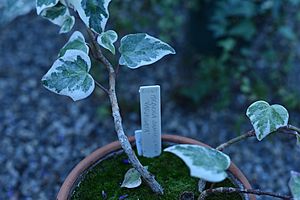Canary Island ivy facts for kids
Quick facts for kids Canary Island ivy |
|
|---|---|
 |
|
| Juvenile leaves, Gomera, Canary Islands | |
| Scientific classification | |
| Genus: |
Hedera
|
| Species: |
canariensis
|
| Synonyms | |
|
|
Canary Island ivy (also called Canary ivy or Madeira ivy) is a type of ivy plant. Its scientific name is Hedera canariensis. This plant originally comes from the Canary Islands. It might also grow naturally along the Atlantic coast of northern Africa.
Contents
What is Canary Island Ivy?
Canary Island ivy is an evergreen plant. This means its leaves stay green all year round. It is also a perennial plant, which means it lives for more than two years. It can grow as a climbing plant or spread along the ground.
This woody plant can reach heights of 20 to 30 meters (about 65 to 100 feet). It grows tall when it has surfaces to climb on. These surfaces can be trees, cliffs, or walls. If there are no vertical surfaces, it spreads out as ground cover. It climbs using special small roots called aerial rootlets. These rootlets help the plant stick to whatever it is climbing.
In warm places, Canary Island ivy grows very fast. It gets established quicker than other types of ivy. This plant is endemic to the Canary Islands. "Endemic" means it is found only in that specific place. It is very common there, especially in the Laurel forests.
Leaves, Flowers, and Stems
The leaves of Hedera canariensis are large. They are usually 5 to 20 centimeters (2 to 8 inches) wide. The leaves are shiny and dark green. They feel a bit leathery. Each leaf usually has 1 to 5 lobes, which are like rounded sections. The leaves are all similar in size and shape.
People often grow this ivy in gardens. It is also used in flower arrangements. The plant's flowers are greenish. Its fruits are round and turn black when they are ripe. Young stems of the plant are green or greenish-brown. Sometimes they have a red or purple tint. As the plant gets older, the stems turn grey or grey-brown.
Where Does Ivy Grow?
Ivy plants are climbing plants. They have evergreen leaves. They often grow from the bottom of ravines and river canyons. They can cover the entire surface of a wall or cliff. Ivy climbs using special roots called adventitious roots. These roots can help the plant reach up to 50 meters (164 feet) in length.
Ivies are plants that are well-suited to the laurel forest habitat. A laurel forest is a type of cloud forest. For example, European Ivy is thought to have spread by birds. Birds helped it grow in large areas where it had disappeared. This happened after the ice ages.
Ivy's Ancient History
Ivy is a very old type of plant. It is one of the plants that survived from the laurel forests. These forests once covered much of the Mediterranean Basin. This was during the Tertiary era, when the climate was more humid.
About ten thousand years ago, at the end of the Pleistocene era, the climate changed. The Mediterranean Basin became much drier. Because of this, the laurel forests there disappeared. Today, laurel forests still exist in some places. These include islands and coastal areas in the North Atlantic Ocean. The climate in these places is not as extreme.
Ivies are "opportunistic species." This means they can grow in many different places. They have close relatives but only a few species. This suggests that different ivy species have developed recently. Birds help spread ivy seeds.
The Hedera ivy found on the Macaronesian islands is closely related to ivy from northern Africa and Europe. For a long time, people thought there was only one ivy species, Hedera helix. But recent studies show there are several species. They mainly differ in tiny details of the hairs on their buds. The way Hedera species developed is due to something called "vicariance." This happens when a large area where a common ancestor plant lived gets broken up. This happened during the Tertiary period.
See also
 In Spanish: Hiedra de Canarias para niños
In Spanish: Hiedra de Canarias para niños


